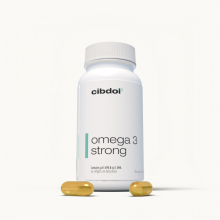Is It Possible to Get Too Much Omega-3 Fatty Acids?
Published:
Omega-3 fatty acids provide many health benefits. The main omega-3s in the diet are ALA, EPA and DHA. Omega-3s support heart health, brain function, healthy aging and more.
Contents:
- What Are Omega-3 Fatty Acids?
- Signs of Excessive Omega-3 Intake
- Established Upper Limits for Omega-3s
- Dosage Recommendations for Omega-3 Supplements
- Potential Health Risks of Too Much Omega-3
- Benefits of Moderately High Omega-3 Intake
- Dietary Sources Are Unlikely to Exceed Limits
- Signs You May Need More Omega-3
- Omega-3 Takeaways
- Conclusion
Due to the benefits, omega-3 supplements like fish oil are popular. This raises the question - can you have too much omega-3? Are high doses unsafe?
Let's examine what constitutes excessive omega-3 intake, potential side effects, and safe upper limits.

What Are Omega-3 Fatty Acids?
Omega-3s are polyunsaturated fatty acids crucial for health. There are three main dietary omega-3s:
- ALA (alpha-linolenic acid): Found in plant foods like flaxseeds.
- EPA (eicosapentaenoic acid): Primarily from seafood.
- DHA (docosahexaenoic acid): Mainly from fatty fish and fish oil.
ALA can convert into EPA and DHA, but only in small amounts. Therefore, seafood and supplements are important for EPA and DHA intake.
Omega-3s provide many evidenced-based health benefits:
- Reduce inflammation and oxidative stress.
- Support brain, eye and heart health.
- Improve mental health and behavior.
- Fight autoimmune diseases and arthritis.
- May help prevent dementia, cancer and stroke.
Signs of Excessive Omega-3 Intake
Consuming extremely high amounts of omega-3s for long periods can cause adverse effects.
Potential signs of too much omega-3 include:
- Nosebleeds and easy bruising: High doses thin the blood.
- Digestive issues: Stomach pain, heartburn, nausea, loose stools.
- Fishy taste and breath.
- Worsening of some autoimmune diseases.
- Increased low-density lipoprotein (LDL) cholesterol.
Very high omega-3 intake may also contribute to bleeding disorders, high blood sugar, fatigue, and suppressed immune function.
However, symptoms typically only occur at combined EPA/DHA doses exceeding 3 grams per day, especially over months or years.
Less common side effects of extremely high single doses include heartburn, nausea, and diarrhea.
Established Upper Limits for Omega-3s
Authoritative groups have defined safe upper limits for combined EPA + DHA omega-3 intake:
European Food Safety Authority (EFSA)
The EFSA sets a safe upper limit for combined EPA + DHA at no more than 5 grams per day for adults.
World Health Organization (WHO)
WHO recommends adults consume no more than 3-4 grams combined EPA + DHA daily. Pregnant/nursing women should not exceed 3 grams per day.
Food and Nutrition Board, Institute of Medicine (IOM)
The IOM establishes the Tolerable Upper Intake Level (UL) for adults at 3 grams/day for combined DHA + EPA.
National Institutes of Health (NIH)
NIH recommends an upper limit of no more than 2 grams/day of combined EPA + DHA.
Dosage Recommendations for Omega-3 Supplements
Based on the established upper limits, here are conservative daily dosage recommendations for omega-3 supplements according to medical and nutrition experts:
Healthy Adults
500 - 1,000 mg combined EPA + DHA is widely considered safe for healthy adults.
Up to 2,000 mg daily is generally well tolerated, especially for short time periods.
Aim for 1-2 servings of fatty fish per week in addition to lower supplemental doses of 500-1,000 mg.
Pregnant & Breastfeeding Women
Pregnant/nursing women can safely take up to 1,000 mg combined EPA + DHA daily, based on WHO recommendations.
Some doctors may recommend slightly higher temporary doses of up to 2,000 mg under medical supervision.
Children
Children's supplemental omega-3 intake should be lower than adults relative to their size.
Estimated maximum amounts for children.
- 1-3 years: 200 mg EPA + DHA.
- 4-8 years: 250 mg EPA + DHA.
- 9-13 years: 400 mg EPA + DHA.
Always check with a pediatrician before giving supplements.
Patients with Certain Diseases
People with risk factors for bleeding disorders or taking blood thinners should not exceed 1,000 mg combined EPA + DHA daily without medical approval.
For autoimmune diseases like lupus or RA, doses above 3 grams may worsen symptoms. Stay under 3 grams unless advised otherwise by your doctor.
Conservative upper limits for omega-3 intake are important for safety. While higher amounts have been tested under medical care, regular daily intake exceeding 3 grams EPA + DHA can potentially lead to adverse effects in some individuals.
Potential Health Risks of Too Much Omega-3
Here is more detail on potential side effects of very high omega-3 intake:
Effects on Bleeding
Excessive doses can prolong bleeding times by reducing blood clotting. This raises the risk of bruising and bleeding disorders (11).
People with bleeding disorders or taking blood thinners/anticoagulants should not exceed 3 grams combined EPA + DHA daily unless medically supervised.
Digestive Side Effects
High omega-3 doses may cause unpleasant but generally not dangerous GI issues like nausea, diarrhea, bloating, and stomach pains.
Enteric-coated capsules and taking supplements with meals often help reduce these side effects.
Elevated LDL Cholesterol
Some research links very high omega-3 intake, especially DHA, to moderate increases in LDL ("bad") cholesterol. However, results have been mixed.
DHA may raise LDL due to increasing the size of LDL particles, which is linked to lower CVD risk. But for those with already high LDL, it's best to stay under 3 grams of omega-3s daily.
Immune System Suppression
Animal studies suggest excessive omega-3 intake could potentially reduce immune function and response. Overall evidence is limited thus far in humans.
Nonetheless, doses exceeding 3 grams daily could theoretically impair immunity, particularly over long periods. Those with compromised immunity may want to limit supplemental omega-3s.
Worsening Autoimmune Disease
Some patients with lupus, rheumatoid arthritis, or psoriasis report symptom flares from omega-3 doses over 3 grams per day. Stay under this amount with autoimmune conditions unless advised otherwise by your doctor.
Very high intake may excessively reduce inflammation and immune activity, leading to worsening symptoms in some cases.
Moderately high levels within established upper limits are unlikely to cause problems in most people. But excessive long-term intake can possibly lead to side effects.
Benefits of Moderately High Omega-3 Intake
While too much omega-3 may be harmful, moderate daily doses up to 2 grams combined EPA+DHA are linked to additional benefits:
Cardiovascular Disease
Doses up to 2 grams per day further reduce blood triglycerides and may improve other CVD risk factors.
Higher intake, especially from oily fish, is associated with significantly lower rates of heart attacks, CHD deaths and strokes.
Mental Health
Daily EPA + DHA doses up to 2 grams have been shown to:
- More effectively lower depression and anxiety.
- Improve behavior and sociability for autism.
- Slow mental decline in older adults with mild impairment.
Inflammatory Diseases
Intakes up to 2-3 grams per day demonstrate anti-inflammatory benefits for:
- Rheumatoid arthritis.
- Ulcerative colitis.
- Non-alcoholic fatty liver disease.
Unless contraindicated for specific conditions, moderately high omega-3 intake within established upper limits provides additional therapeutic advantages.
Dietary Sources Are Unlikely to Exceed Limits
For most people, excessive omega-3 intake from foods is very unlikely. To reach 3 grams from diet alone, you would need to eat large amounts of seafood and oils daily.
However, high-dose supplements without medical guidance could potentially surpass conservative upper limits.
Here's EPA + DHA provided by common dietary sources, which are safe amounts for daily consumption:
- 6oz salmon: around 2 grams.
- 6oz tuna: roughly 1 gram.
- 1 tbsp flaxseed oil: about 0.7 grams.
- 1oz walnuts: approximately 0.3 grams.
High daily fish servings or tablespoons of oils would be needed to approach 3 grams from foods alone.
While a diet rich in omega-3s is very healthy, excessive supplements may raise concerns in some individuals.
Signs You May Need More Omega-3
Rather than taking increasingly higher doses, pay attention for signs you may need more essential omega-3 fatty acids in balance:
- Dry, flaky or itchy skin.
- Fatigue, weakness or poor endurance.
- Poor circulation, numbness in hands/feet.
- Depression, mood changes or irritability.
- Cognitive decline, poor memory or focus.
- Eye discomfort, blurred vision or dry eyes.
- Joint pain, stiffness, swelling or arthritis.
Talk to your doctor if experiencing any of these symptoms. Blood tests can check omega-3 levels to determine if more omega-3s from seafood or balanced supplements at moderate doses may help.
Omega-3 Takeaways
In summary:
- Authoritative groups set conservative upper limits for combined EPA + DHA at 2-3 grams per day.
- Side effects are unlikely below 3 grams per day. But possible adverse effects include bleeding disorders, digestive issues, worsened autoimmunity, and elevated LDL cholesterol.
- Very high omega-3 doses for long periods may suppress immune function.
- For healthy adults, 500-1,000 mg EPA + DHA daily from supplements is widely considered safe.
- Natural dietary sources like seafood and oils alone are unlikely to provide excessive amounts.
- Pay attention to signs you may need more omega-3 rather than increasingly high supplement doses.
Conclusion
Omega-3 fatty acids are very beneficial for health, but too much can be problematic. To avoid potential side effects, do not exceed 2-3 grams combined EPA + DHA daily from supplements without medical supervision.
Focus on including omega-3-rich foods like fatty fish 1-2 times per week and daily plant sources like flaxseeds, walnuts and oils. If taking supplements, carefully follow dosage guidance for your age and condition.
Seek professional advice if experiencing concerning symptoms or considering very high omega-3 doses above conservative upper limits. More omega-3s is not always better - moderation is key to safely gaining their extensive health advantages.










